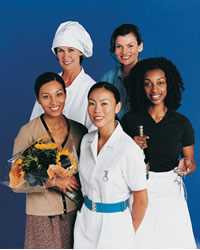Women's Safety and Health Issues at Work

Job Area: Services
In 2004, the Bureau of Labor Statistics estimated over 29 million women were working in service jobs. This includes jobs such as finance, insurance, food service, education, entertainment, and public administration. In 2003, almost half of the job-related injuries and illnesses suffered by women happened in service jobs, yet only 20% of working women held these jobs.1 Women working in service jobs may be concerned with musculoskeletal disorders, workplace violence and injuries from falls.
NIOSH Publications
Controlling Chemical Hazards During the Application of Artificial Fingernails (Hazard Control 28)
DHHS (NIOSH) Publication No. 99-112 (January, 1999)
CDC Publications
Controlling Chemical Hazards During the Application of Artificial Fingernails (Hazard Control 28)
DHHS (NIOSH) Publication No. 99-112 (January, 1999)
CDC Publications
Administrative Professional Health and Safety Tips
Related Resources
Adverse health outcomes among cosmetologists and noncosmetologists in the Reproductive Outcomes of Salon Employees (ROSE) study
Cosmetologists completed surveys about health problems, including those related to cardiovascular, skin and respiratory health issues. When their responses were compared to women in other occupations, the cosmetologists were at a significantly higher risk of depression. No other associations were statistically significant between cosmetologists and adverse health outcomes.
Biological exposure assessment to tetrachloroethylene for workers in the dry cleaning industry
The study assessed the feasibility of conducting biological tetrachloroethylene (perchloroethylene, PCE) exposure assessments of 18 female dry cleaning employees in conjunction with evaluation of possible PCE health effects.
Characteristics of persons and jobs with needlestick injuries in a national data set
When occupational data was examined for needlesticks, women made up 73% of the people injured. Occupations with greatest frequencies included registered nurses, nursing aides and orderlies, janitors and cleaners, licensed practical nurses, and maids and housemen. Occupations with greatest risks included biologic technicians, janitors and cleaners, and maids and housemen.
Earlier age at menopause, work, and tobacco smoke exposure
Among women over age 25, earlier age at menopause was found among all smokers and among service and manufacturing industry sector workers. Women (particularly black women) age 25 to 50 had an increased risk of earlier age at menopause with both primary smoking and second-hand smoke (SHS) exposure. Control of SHS exposure in the workplace may decrease the risk of death and disease associated with earlier age at menopause in US women workers.
Gender and age differences in posttraumatic stress disorder and depression among Buffalo police officers
This study looked at the possibility of increased change for and depression and posttraumatic stress disorder (PTSD) in police officers. The study found the frequency of depression was greater among women (22.0%) than men (12.1%), yet differences were less evident for PTSD (36.6% women, 34.5% men). Depression and PTSD seemed to increase with age and were not explained by gender, marital status, or education.
Mortality and end-stage renal disease incidence among dry cleaning workers
Eight years of data were added to a study of dry cleaners in four cities. It was concluded that employment in the dry cleaning industry and occupational exposure to perchloroethylene are associated with an increased risk for end stage renal disease and for cancer at several sites.
Mortality in dry-cleaning workers: an update
This study looked at dry-cleaning workers who were exposed to perchloroethylene (PCE), to see if there was a higher rate of death caused by cancer. Researchers found a possible link between formaldehyde exposure and dying of myeloid leukemia.
Nail salon hazards and health effects
Surveys completed by nail technicians identified as common work-related musculoskeletal disorders, skin problems, respiratory irritation and headaches. Assessment found that 16 of 22 nail salons in the study had no mechanical ventilation of any kind other than table fans and room air cleaners.
Premature ovarian failure among hairdressers
Among Caucasian women 40-55 years of age, hairdressers were more than five times as likely to report premature ovarian failure compared with non-hairdressers.
Prevalence of respiratory symptoms among female flight attendants and teachers
Potential health effects of the indoor environment in office buildings and aircraft have generated considerable concern in recent years. This study looked at the frequency of self reported respiratory symptoms and illnesses in flight attendants (FAs) and schoolteachers. The study found FAs and teachers report a higher frequency of work- related upper respiratory symptoms, chest illness, and cold or flu than the general working population.
Somatic symptoms among cosmetologists compared to women in other occupations
The results of this survey-based study indicate that cosmetologists are at increased risk of memory disturbances, sleep disturbances, muscle weakness, throat irritation, and hot flashes compared to women of the same age working in other occupations.
Video display terminals and the risk of spontaneous abortion
Telephone operators who used video display terminals (VDTs) at work were compared with non-VDT-users; 2,430 women were interviewed. No higher chance of reduced birth weight, preterm birth, or miscarriage was found to be associated with any VDT use during pregnancy.
Work with video display terminals and the risk of reduced birthweight and preterm birth
This study looked at the risk of reduced birthweight and preterm births among workers who used video display terminals (VDTs). The study found workplace use of VDTs was not associated with reduced birthweight or preterm birth.
- Hoskins, A. Occupational injuries, illnesses, and fatalities among women. Monthly Labor Review Online. 2005.
- Page last reviewed: April 23, 2012
- Page last updated: August 27, 2013
- Content source:
- National Institute for Occupational Safety and Health
Office of the Director
- National Institute for Occupational Safety and Health


 ShareCompartir
ShareCompartir